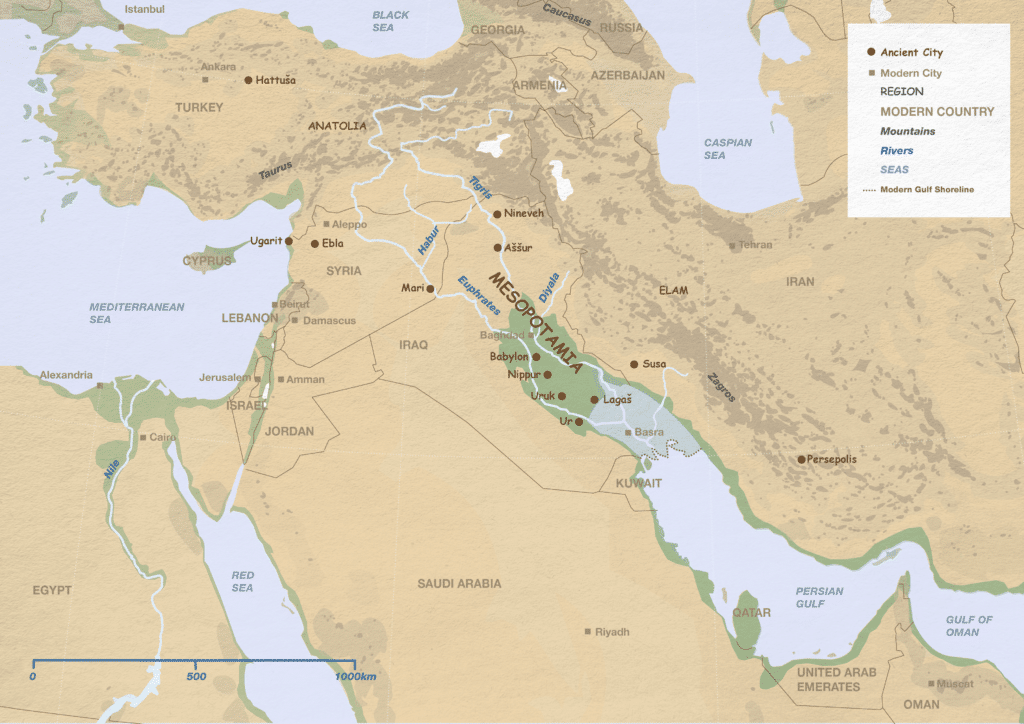The Greeks described it as a paradise. Yet nothing is easy there, especially in the south: a desert, arid region, where rainfall is scarce; where clay is everywhere while stones are nowhere to be seen; where palm trees cover acres, while other trees are rare.
Cultivating was not an easy task: irrigation was necessary to turn the desert into a green prosperous land.
Together with the organisation of a more and more complex irrigation network, the villages grew up into bigger and bigger cities, and society became more and more complex.
- Cities and State were born
- Cuneiform writing was invented
- Trade started with both neighbouring and faraway regions
The history of Mesopotamia started millennia ago. When the first farmers settled down in small villages along the rivers.

So long, too
many facts to remember. I
don’t know much about the old
Sumerian kings, except
Gilgameš.
First, there was Sumer
A region in the south full of city-states, each with their own gods, each with their own kings, often at war with each other for a field or the control of a canal.
Then a single man rose to power and established an Empire: Sargon
He is no Sumerian, he is Akkadian; he is an orphan found in a cradle on the river, raised by the goddess Ištar. Servant of the Sumerian king, he overthrows him, takes the power and conquers all Mesopotamia.
But Sargon’s empire does not long survive to its founder, and collapses under the thrust of eastern invaders.
Sumerians come back in the spotlight
Soon the capital of a new Empire is the city of Ur: new conquests, new unity of the Land of Sumer and Akkad, new form of government. But the new empire does not last long, and succumbs to an administrative nightmare and... invaders from the East. The History of Mesopotamia is a long, turbulent one, full of conflicts and wars, and the rise and fall of Empires.
Babylon rises
The old cities regain their power and independence, under the rules of new kings, who are no longer Sumerians and speak a different language: Akkadian. They form a myriad of small kingdoms that all try to reunite the Land of Sumer and Akkad on their. Only one will succeed: Babylon.
The great king Hammu-rabi of Babylon establishes a vast empire, ruling over all Mesopotamia. He creates a law code.
The club of the Great Powers dominates Near East
Four powerful states rule over Near East: the kingdom of the Hittites in Anatolia, of Mitanni in northern Mesopotamia, of the Kassites in Babylonia and Egypt.
They continuously interact with one another as both equals and rivals. Hittites and Egyptians both want to gain influence over Syria and the Levant: they fight and sign treaties to define their domination over the region.
The mysterious “sea people” ruin this fragile balance. They devastate Syria and the Levant; they put an end to the power of the Hittite kingdom. But two centuries later, newcomers, the Hittites, sack Babylon and put an end to the first Babylonian Empire.
Assyria rises
The Assyrian kingdom, who had overthrown the kingdom of Mitanni, takes advantage of the new situation. Assyrians are fierce and merciless warriors who spread fear over all Near East. They conquer many countries and establish the largest territorial empire ever seen before.
But many conflicts for the succession to the throne weaken the Assyrian empire and the last capital, Nineveh, cannot resist to the Babylonian attack.
Babylon regains its past glory
For a brief timespan, Babylon regains all its past glory, and dominates in its turn all Near East under the rule of powerful kings, such as Nebuchadnezzar.
Babylonian culture fades away
Persians put an end to the glory of Babylon, then Alexander the Great conquers Mesopotamia.
ca 6500 – 4000 - Ubaid Period
ca 4000 – 3000 - Uruk Period
ca 2800 – 2340 - Early Dynastic periods
ca 2340 – 2200 - Empire of Sargon
ca 2100 – 2000 - Ur III empire
ca 1900 – 1761 - Amorites kingdoms
ca 1761 – 1594 - First Babylonian Empir
ca 1500 - 1200 - Domination of the “four great powers”
ca 1200 - Invasion of the “Sea people”
ca 900 - 612 - Assyrian empire
ca 625 - 539 - Neo-Babylonian Empire
530 - 331- Persian Empire
331 - Conquest of Alexander
331-129 - Seleucid period
No Mesopotamian cities will ever regain political power. But Babylonian culture survives. The scribes go on copying ancient texts during the reign of Alexander’s successors and transmit Babylonian knowledge to the generations to come.
Fascinating civilisations came to life in Mesopotamia, along the Tigris and the Euphrates. Sumerians, Akkadians, Babylonians, Assyrians, all of them astound us by their ingenuity and creativity.

